Order:
Anura
(Frogs and Toads)
The following
taxonomic list will link you to the individual species.
Family:
Ascaphidae
|
The
family Ascaphidae is a primitive family as evidenced by a higher than
normal number of vertebrae (9 presacral), the vertebrae shape, the presence
of ribs and a high chromosome number (Nussbaum et al. 1983). The family
is represented by a single living species, the Tailed Frog (Ascaphus
truei). This species is endemic to the Pacific Northwest (Pough et al. 1998).
to the Pacific Northwest (Pough et al. 1998).
|
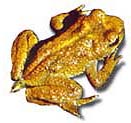
|
|
|
Family:
Bufonidae
(True Toads)
This
family is nearly cosmopolitan in distribution. In North America the family
is represented by a single genus Bufo. Characteristics of the True
Toads are the absence of teeth in the upper jaw, a peculiar structure (Bidder's
organ) near the testes of males, and heavily ossified
skulls (Pough 1998). The two species present in Idaho have the stereotypical
"toad" body form (a relatively squat body with short legs and
rough bumpy skin due to poison glands).
(Pough 1998). The two species present in Idaho have the stereotypical
"toad" body form (a relatively squat body with short legs and
rough bumpy skin due to poison glands). |
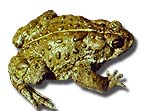 |
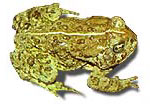 |
Bufo
boreas
Western Toad |
Bufo
woodhouseii
Woodhouse's Toad |
Family:
Pelobatidae
(Archaic Toads)
The
family Pelobatidae is a fairly primitive family (as the name implies). Primitive
features include a distinctive skeletal morphology, inguinal
amplexus and vertical pupils (Nussbaum et al. 1983). The species in this family can
be distinguished from true toads by the presence of teeth in the upper jaw.
The single species found here in Idaho is the Great Basin Spadefoot Toad,
Scaphiopus intermontanus ( = Spea intermontana).
and vertical pupils (Nussbaum et al. 1983). The species in this family can
be distinguished from true toads by the presence of teeth in the upper jaw.
The single species found here in Idaho is the Great Basin Spadefoot Toad,
Scaphiopus intermontanus ( = Spea intermontana). |

|
|
|
Family:
Hylidae
(True Tree Frogs)
The
family Hylidae is found throughout the Americas, Europe and northern Asia
and Africa. This family is most diversely represented in tropical South
America. The Pacific Northwest is represented by two genera, Hyla and
Pseudacris (Nussbaum et al. 1983). Idaho has two species
in this family, Hyla regilla and Pseudacris maculata.
The Pacific Treefrog is referred to by some scientists as the Pacific
Chorus Frog (Pseudacris regilla). There currently seems to
be no major consensus as to which name is most appropriate. The
Boreal Chorus Frog (Pseudacris maculata) is a new name, formerly
being a subspecies (P. triseriata maculata).
All
members of the family have intercalary
cartilage between the ultimate and penultimate phalanges (Nussbaum et al. 1983)
which, with arboreal species having developed toe pads, may allow better
adhesion . Most species in the family have long slender limbs (which,
again may facilitate an arboreal lifestyle).
between the ultimate and penultimate phalanges (Nussbaum et al. 1983)
which, with arboreal species having developed toe pads, may allow better
adhesion . Most species in the family have long slender limbs (which,
again may facilitate an arboreal lifestyle).
|
 |
Pseudacris
regilla
Pacific Treefrog |
|
|
 |
Pseudacris
maculata
Boreal Chorus Frog |
Family:
Ranidae
(True Frogs)
| The
family Ranidae is a large and diverse family, with representatives on many
different continents and from many different habitats. There are around
45 genera in the family world wide, but there is only one found in North
America, the genus Rana. The genus Rana has four representatives
in Idaho: Rana catesbeiana, Rana pipiens, Rana luteiventris and
Rana sylvatica. |
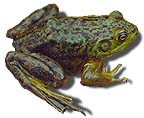 |
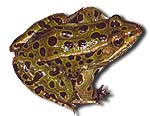 |
|
|
|
 |
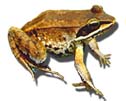 |
|
|
|
Written
by John Cossel Jr., 1997
Photos by Charles R. Peterson, Edward Koch, Jonathon M. Beck, Michael E. Dorcas
and Larry West
![]() to the Pacific Northwest (Pough et al. 1998).
to the Pacific Northwest (Pough et al. 1998).









